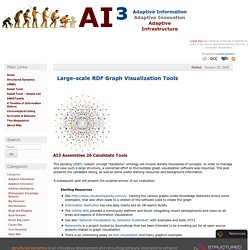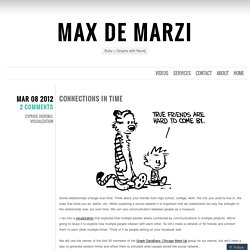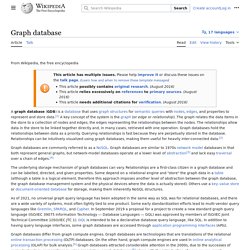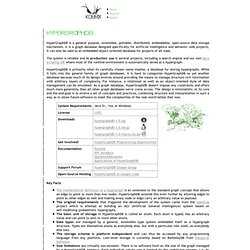Zoom
Trash

Max De Marzi. InfiniteGraph, the Distributed Graph Database. PhpCallGraph - A Static Call Graph Generator for PHP. Graph JavaScript framework, version 0.0.1 - JavaScript - Snipplr. Gephi, an open source graph visualization and manipulation software. The Gephi Consortium. RDF Graph visualization tools « Time rolls on. Large-scale RDF Graph Visualization Tools. AI3 Assembles 26 Candidate Tools The pending UMBEL subject concept “backbone” ontology will involve literally thousands of concepts.

In order to manage and view such a large structure, a concerted effort to find suitable graph visualization software was mounted. This post presents the candidate listing, as well as some useful starting resources and background information. A subsequent post will present the surprise winner of our evaluation. Starting Resources Various Example Visualizations For grins, you may also like to see various example visualizations, most with a large-graph bent: Software Options Here is the listing of 26 candidate graph visualization programs assembled to date: Cytoscape – this tool, based on GINY and Piccolo (see below), is under active use by the bioinformatics community and highly recommended by Bio2RDF.org GINY implements a very innovative system for sub-graphing and allows for stunning visuals. Headline: Large-scale RDF Graph Visualization Tools alternativeHeadline: Dydra.
Jena Semantic Web Framework - Documentation Overview. Connections in Time. Some relationships change over time.

Think about your friends from high school, college, work, the city you used to live in, the ones that liked you ex- better, etc. When exploring a social network it is important that we understand not only the strength of the relationship now, but over time. We can use communication between people as a measure. I ran into a visualization that explored how multiple parties where connected by communications in multiple projects.
We’re going to reuse it to explore how multiple people interact with each other. Let’s give our network a little something special. The code to create a relationship is pretty simple, we’ll use the Batch commands again and reference the nodes we create. Let’s put it together to create our graph. Our visualization was built using D3.js and it makes a web request expecting to see a JSON object that looks like: We spent some time getting our data into our graph, now let’s get it all back out. Like this: Like Loading... Graph database. Graph databases are part of the NoSQL databases created to address the limitations of the existing relational databases.

While the graph model explicitly lays out the dependencies between nodes of data, the relational model and other NoSQL database models link the data by implicit connections. Graph databases, by design, allow simple and fast retrieval[citation needed] of complex hierarchical structures that are difficult to model[according to whom?] In relational systems. Graph databases are similar to 1970s network model databases in that both represent general graphs, but network-model databases operate at a lower level of abstraction[3] and lack easy traversal over a chain of edges.[4] Graph databases differ from graph compute engines.
Background Graph databases, on the other hand, portrays the data as it is viewed conceptually. Graph Graph databases employ nodes, properties, and edges. Graph-database.org. Marko A. Rodriguez. HyperGraphDB - A Graph Database. HyperGraphDB is a general purpose, extensible, portable, distributed, embeddable, open-source data storage mechanism.

It is a graph database designed specifically for artificial intelligence and semantic web projects, it can also be used as an embedded object-oriented database for projects of all sizes. The system is reliable and in production use is several projects, including a search engine and our own Seco scripting IDE where most of the runtime environment is automatically saved as a hypergraph. HyperGraphDB is primarily what its carefully chosen name implies: a database for storing hypergraphs.
While it falls into the general family of graph databases, it is hard to categorize HyperGraphDB as yet another database because much of its design evolves around providing the means to manage structure-rich information with arbitrary layers of complexity. For instance, a relational as well as an object-oriented style of data management can be emulated. Key Facts Possible Usage Scenarios.